My wife is a Master gardener and would rather spend time in the garden than do just about anything else. I just do the heavy lifting and digging, but take all the credit when the garden is complemented. A holdover from my working days: when things go well, take full credit, when things go south, blame nursing. I am uncertain just what she is going to do with the 3 by 6 by 6-foot hole she is digging in the back. A water feature? Dunno. She has been tight lipped about it.
Anyhoo.
When we travel, we usually check out any botanical gardens, and I find them fascinating. The variation in plants is remarkable, the best of DEI. Although I wish they had more on the why’s of the plants. What was the environmental pressure that led the plants to evolve to look like that?
When we were in Adelaide, we went to the Adelaide Botanic Garden, one of the better botanic gardens we have seen. As we wandered about, we came across the Garden of Healing:
The Garden of Healing conceptualizes the use of medicinal plants from eastern and western cultures.
Species from the Middle East and Northern African regions, China, India, Indigenous Australia and North and South America have been gathered to form a collection rich in diversity that specializes in healing properties. Themed garden beds have been designed to represent these cultures, as well as western culture, represented by a themed garden bed incorporating medicinal plants from Europe.
The Garden of Healing demonstrates the historical contributions of plants for over 60,000 years, as well as the importance of plants in pharmaceutical discovery and modern medicine. The Garden of Healing is also a necessary platform to aid the understanding of defensive and remedial plant properties for the future.
As I read the plaques in the Garden of Healing, I thought it would be a fun project to compare the content with reality, as they struck me as a bit… gullible? Although it is admitted that they are constrained by space. You can’t put a whole SBM analysis on a small plaque. Can’t make a plaque big enough for a Gorski, which really should be a unit of measurement. As an example, this essay is a quarter Gorski. Let’s not go into what unit of measurement a Crislip would be. Wouldn’t be prudent.
Of course I recognize there is nothing intrinsically unreasonable about plants as a source of efficacious medications. My career was based on giving modified bacterial and fungal products to people. Many a valuable medication originated in plants. However, in the past, treating mostly self-limited diseases with various plants makes causality suspect.
I do not know if I managed to photograph all the plaques. Darkness and rain were heading out way. I was in a bit of a rush, so I likely missed a few and at least one, liverwort, was obscured by the liverwort. Or is that a weed?
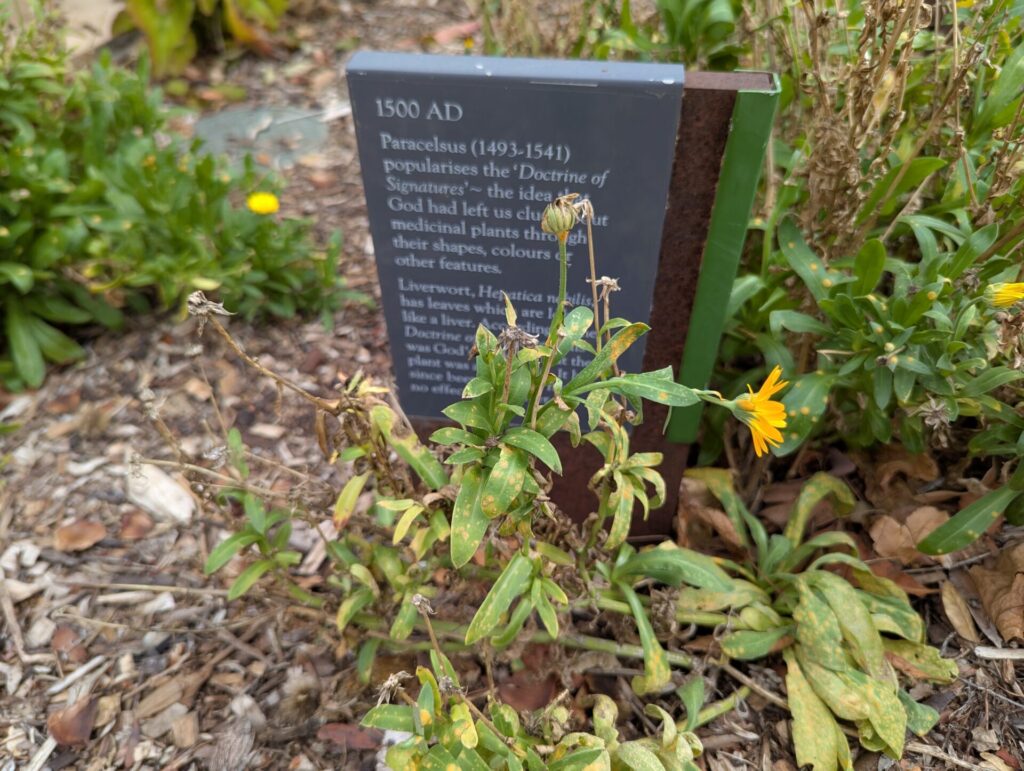
So what liverwort, the plant with the coolest name, was alleged to treat is unknown. Anyone wants to send be back to Adelaide to see, let me know. Do you think it is a good reason for a Go Fund Me? It looks to be Hepatica nobilis. While I can’t read the plaque, a search suggests it is used for liver/gallbladder problems, hence the name. Nothing, however , on the Pubmeds for clinical trials.
A review suggests
Medicinal use of bryophytes dates to ancient times, but it has always been marginal due to their small size, difficult identification, lack of conspicuous organs, which would attract attention (flowers, fruits) and insipid taste of the herb
Insipid taste. I guess it is why I never had a liverwort sandwich.
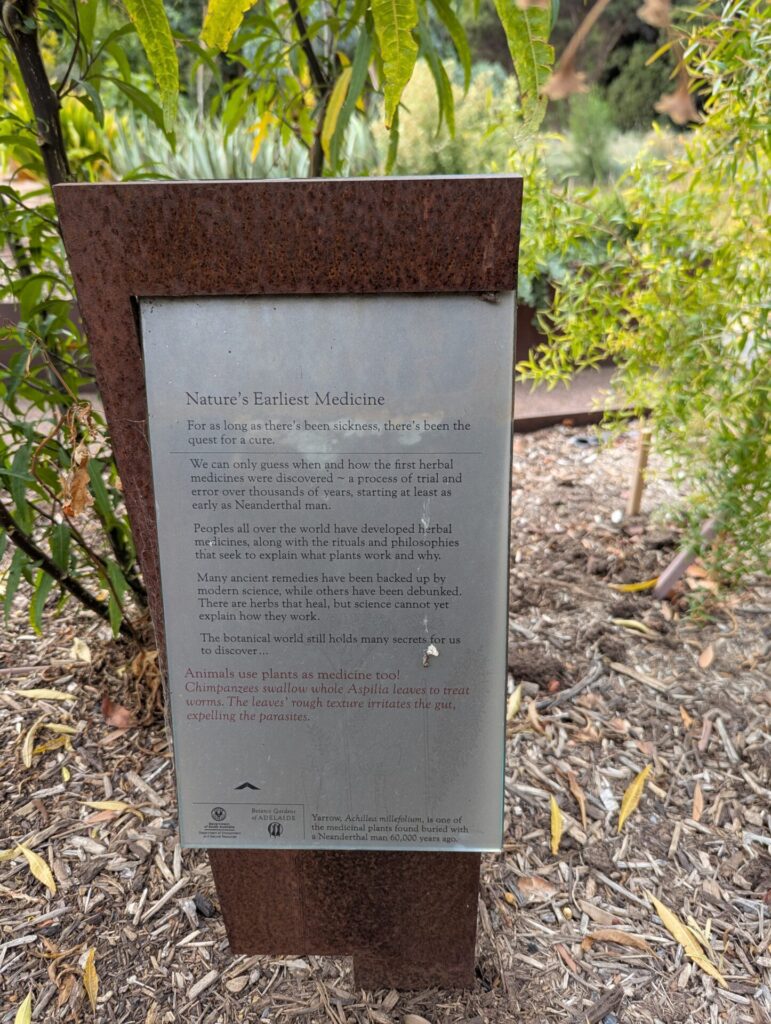
Nature’s Earliest Medicine … People all over the world have developed herbal medicine, along with rituals and philosophies that seek to explain what plants work and why.
But, of course, not IF the plants work. That is the tricky part.
Many ancient remedies have been backed up by modern science, which others have been debunked. There are herbs that heal, but science cannot yet explain how they work.
I do not think I would use debunk. That, for me, is reserved for bat shit crazy divorced from reality, like acupuncture, homeopathy, and tariffs.
Science cannot yet explain how they work.
Yes, it can. If it, indeed, works. Usually such a statement means the intervention does not work and there is nothing to explain. Like homeopathy.
The botanical world still holds many secrets for us to discover
No argument there. Lots of potential treatments likely in plants soon to vanish.
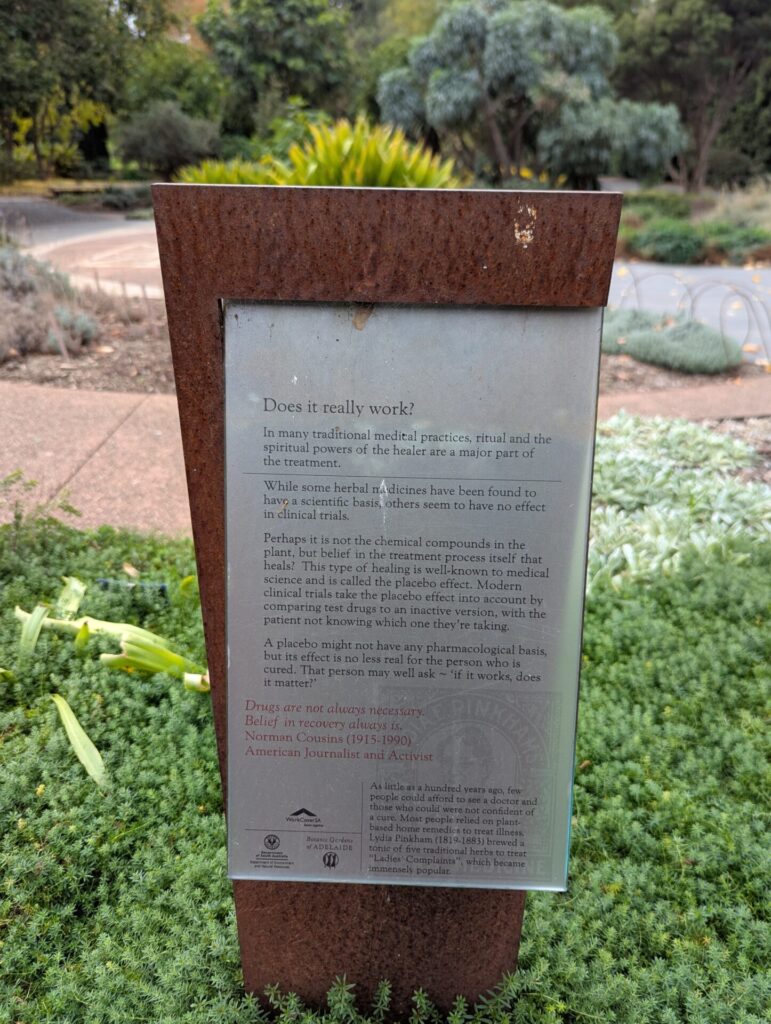
Does it really work?
In many traditional medical practices, ritual and the spiritual powers of the healer are a major part of the treatment.
While some herbal medicines have been found to have a scientific basis, others seem to have no effect in clinical trials.
Seem to have no effect in clinical trials? So they don’t work, simple enough. Do you think the Garden of Health will go to the trouble of identifying which plants have potential and which have been shown as worthless? A vital piece of information, I would think. But you know the answer. Of course not.
Perhaps it is not the chemical compounds in the plant, but the belief in the treatment process itself that heals? This type of healing is well known to medical science and is called the placebo effect. Modern clinical trials take the placebo effect into account by comparing test drugs to an inactive version with the patient not knowing which one they’re taking.
A placebo might not have any pharmacological basis, but its effects are no less real for those who is cured. The person may well ask, if it works, does it matter?
Then why have a garden of healing at all? Such a lack of understanding of placebo. And it matters if you are treating anything serious or paying for it.
Drugs are not always necessary, but belief in recovery always is. Norman Cousins.
It is one of those aphorisms that sounds good until you think about it. I cured many an infection and belief in recovery played no role nor did lack of belief result in treatment failure.
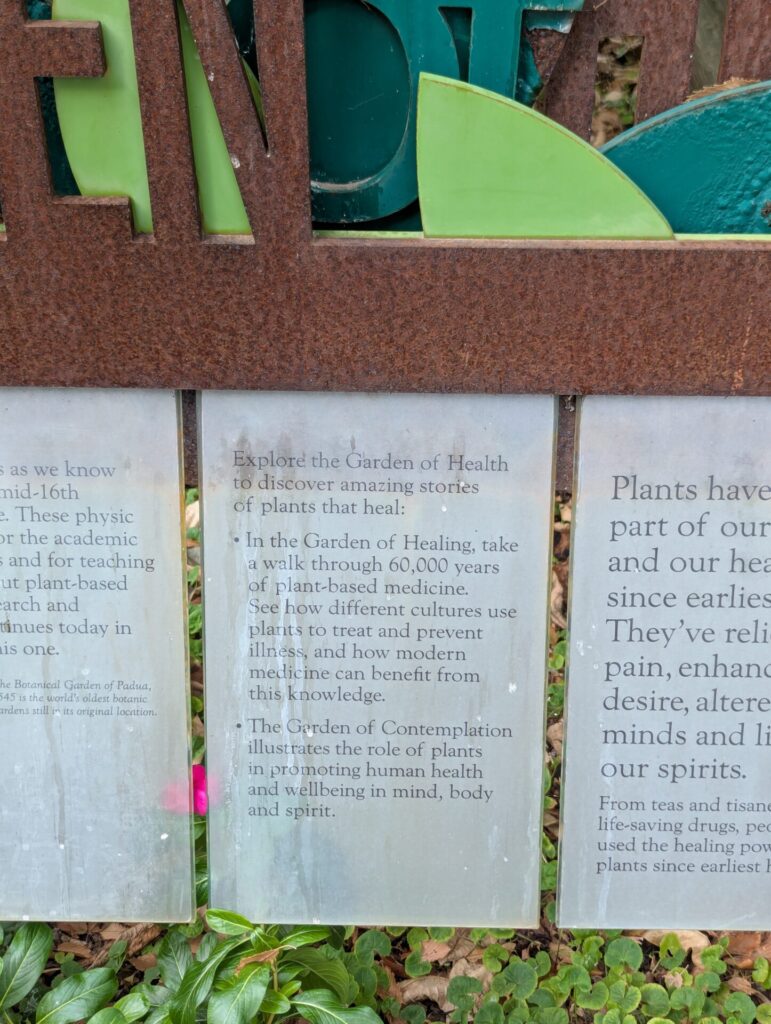
Explore the Garden of Health to discover the amazing stories of plants that heal
In the Garden of Healing, wake a walk through 60,000 years of plant-based medicine. See how different cultures use plants to treat and prevent illness and how modern medicine can benefit from this knowledge.
Plants have been part of our lives and our health since earliest time. They’ve relieved pain, enhanced desire, altered out minds and lifted out spirits.
Oddly, they have neither hops nor barley, the two most important plants that when combined relieve pain, enhance desire, alter the mind and lift the spirit.
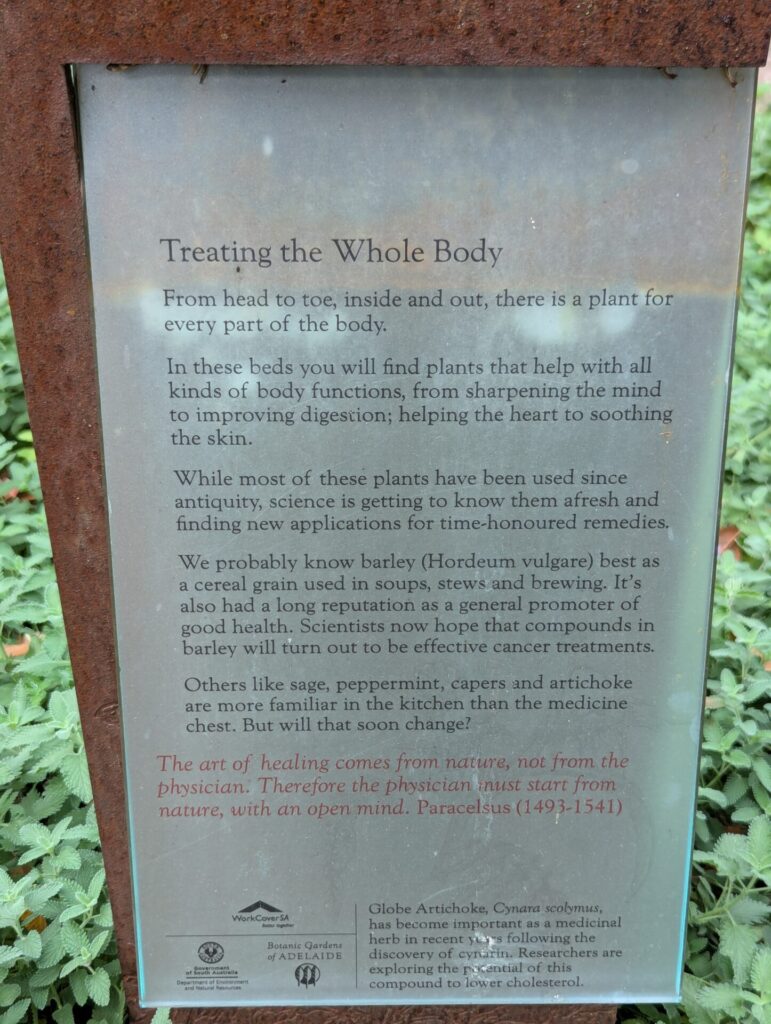
Treating the Whole Body
From head to toe , inside and out, there is a plant for every part of the body.
That is not how biology works. Plants target physiology, not anatomy. I know. It’s an artful simplification for the sake of limited space, but misleading. Just bugs me.
In these beds you will find plants that help with all kinds of body functions, from sharpening the mind, to improving digestion; helping the heart to soothing the skin.
We will see, won’t we?
While most of these plants have been used since antiquity, science is getting to know them afresh and finding new applications for time-honoured remedies.
We probably know barley (Hordeum vulgare) best known as a cereal grain used in soups, stews and brewing. It’s also had a long reputation as a general promoter of good health. Scientists now hope that compounds in barley will turn out to be effective cancer treatments.
There are a few in vitro studies to suggest barley has effects on colon cancer, but it has yet to reach clinical utility. And always remember Cells. And I love the hover-over comment.
The art of healing comes from nature, not from the physician, Therefore, the physician must start from nature, with an open mind,
But not so open that your brain falls out. I will also note, given the mortality from some infectious diseases, nature ain’t doing such a great job.

Plants are the pharmacy of 8o% of the world’s people who depend on traditional medicine for their main form of health care. Many of them are featured in the garden.
I guess that in part explains the low life expectancy of so much of the world through history. I am glad I have not needed to depend on traditional medicine for the three processes that would have killed me in the good old days.
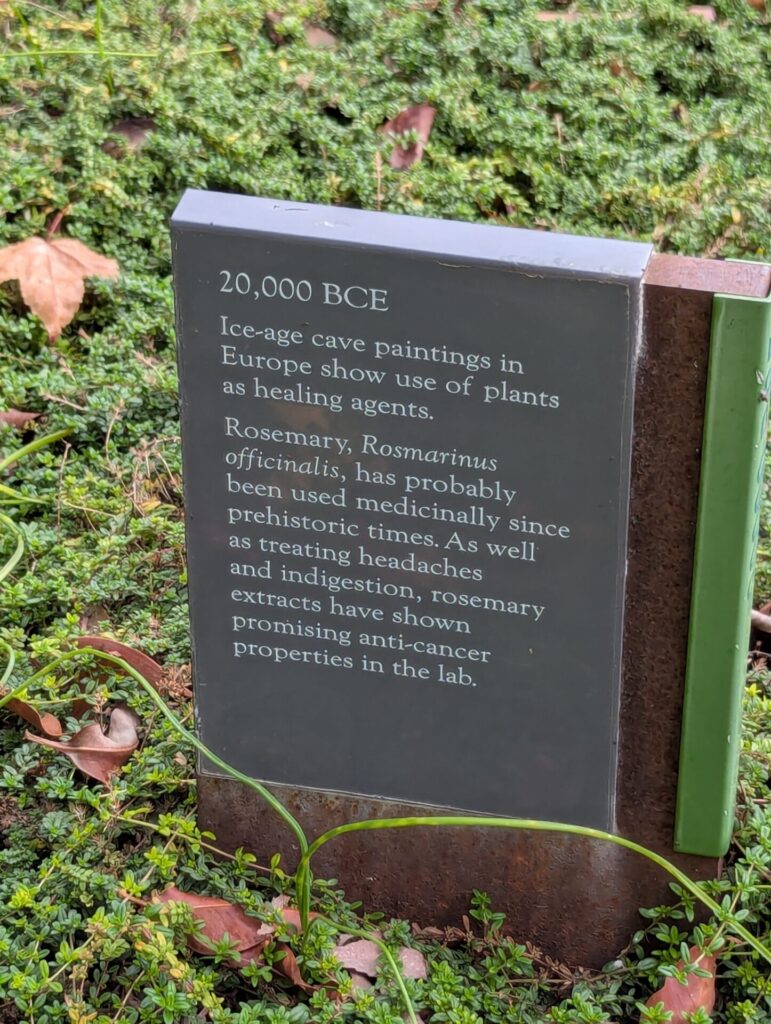
20,000 BCE
Ice-age cave paintings in Europe show the use of plants as healing agent
If so, I can’t find the example. Perhaps my Googe-fu is lacking, and I spent a long time looking.
Of the 5786 depictions identified across 113 European Paleolithic caves, only 0.07% featured plants. Animals and abstract symbols appeared more frequently, 53.7% and 43.3% respectively. The identification of plants from drawings was somewhat ambiguous due to a lack of detail in some images, making interpretation of images difficult in some cases.
Interestingly, the underrepresentation of plants in cave art during the Paleolithic has been reported from other sites outside Europe.
And how do they know that the ice-age cave painting, if it exists, actually shows plants being used for medicinal purposes? Ever since the ludicrous idea that Otzi the Iceman used acupuncture I have been skeptical of ice age interpretations. Hallucinatory conclusions predate AI.
Rosemary, Rosnarinus officinalis, has probably been used medicinally since prehistoric times, As well as treating headaches and indigestion, rosemary extracts have shown promising anti-cancer properties in the lab
On Pubmed, zero hits for clinical trials of rosemary and either headache or indigestion.
For cancer, many chemicals from Rosemary have effects on a wide variety of cancers in the lab.
Rosmarinic acid (RA) and carnosic acid (CA) are potent polyphenolic compounds found in rosemary (Rosmarinus officinalis) extract. They have been extensively studied for their biological properties, which include anti-diabetic, anti-inflammatory, antioxidant, and anticancer activities. In addition, RA and CA have demonstrated effective anti-proliferative properties against various cancers, making them promising targets for extensive research to develop candidate or leading compounds for cancer treatment.
Although as of this writing, no Rosemary product has moved to clinical trials for cancer unless it was the author’s first name.
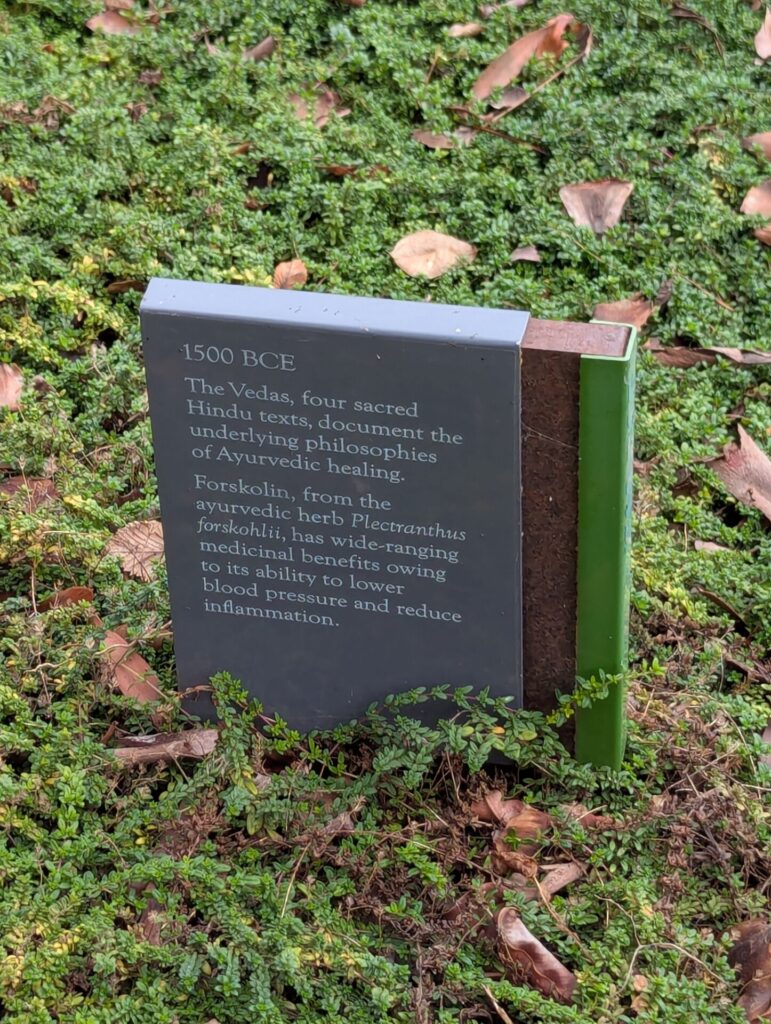
1500 BCE
The Vedas, four sacred Hindu texts, document the underlying philosophies of Ayurvedic healing.
Philosophy, not reality, mind you.
Forskolin, from the Ayurvedic herb Plectranthus forskohlii, has wide-ranging medicinal benefits owing to its ability to lower blood pressure and reduce inflammation.
As to blood pressure, there are few clinical studies. One, Cardiovascular effects of colforsin daropate hydrochloride for acute heart failure after open heart surgery showed
After 2 or 3 hours from administration of COL, heart rate and cardiac index increased, and pulmonary artery pressure and central venous pressure decreased significantly, but blood pressure and systemic venous oxygen saturation did not show significant change.
And another study in obese diabetic men, compared Forskolin to placebo:
Systolic blood pressure changes were not shown to be statistically significant across time, and there were no significant differences among groups at either initial, mid-, or final measurements. In fact, within both groups, a trend toward a significant reduction in systolic blood pressure was shown (p = 0.079 for forskolin vs. p = 0.077 for placebo). No significant difference or trends toward significance were observed for diastolic blood pressure or in the actual change in diastolic blood pressure at any time-point.
So not impressed. Although forskolin and derivatives do appear to have a variety of other effects on the cardiovascular system, none appear to have made it to clinical use. And if circumcised? Could not resist. Sorry.
Reduced inflammation is a tough one, as that can mean damn near anything. In variety of models, it has effects on a variety of inflammatory endpoints. Take your pick. However, I could find no clinical utility.
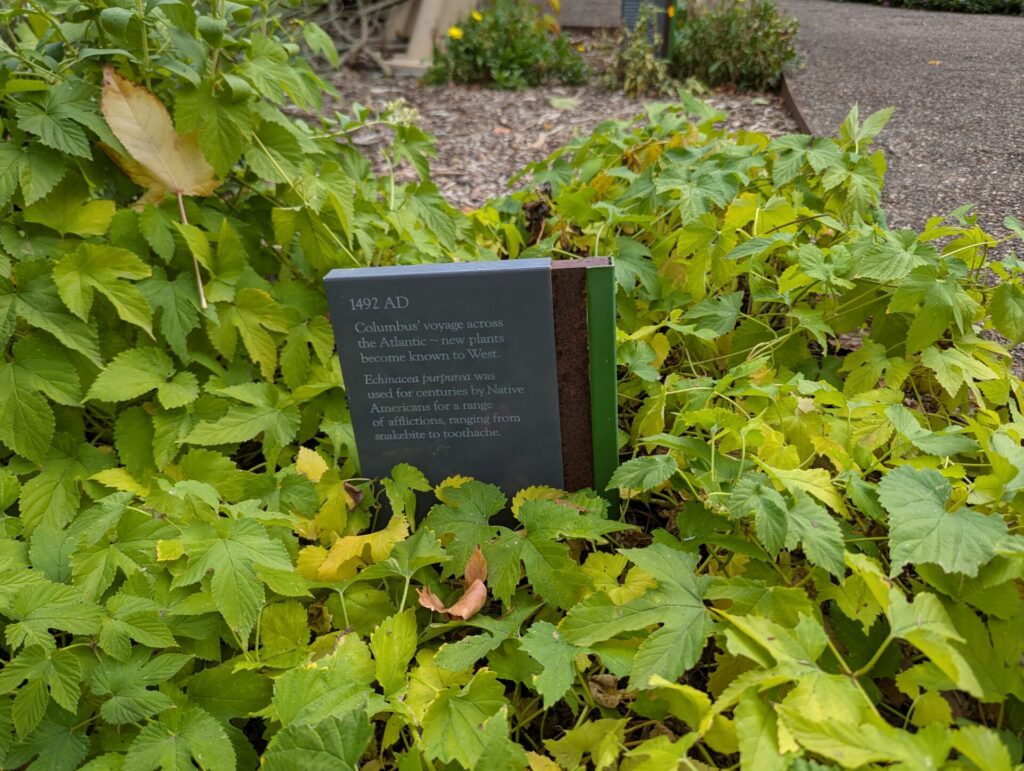
1492 AD
Columbus voyaged across the Atlantic. New plants became known to the West.
Echinacea purpura was used for centuries by Native Americans for a range of afflictions, ranging from snakebite to toothache.
Used Echinacea? Yes. Did it help a snake bite? Doubt it; the Pubmeds are unsurprisingly not helpful for clinical trials. Who would enter such a study, much less organize one? A huge number of herbs are supposed to have effects on snake bites; boy, our forebears got snakebit a lot. Do they work? Who knows? Deadmen tell no tales.
And there are no clinical trials for toothache. Could it help? Maybe. But in an often self-limited process, single tales of efficacy are useless. As has been said many times, the plural of anecdote is anecdotes, not data.
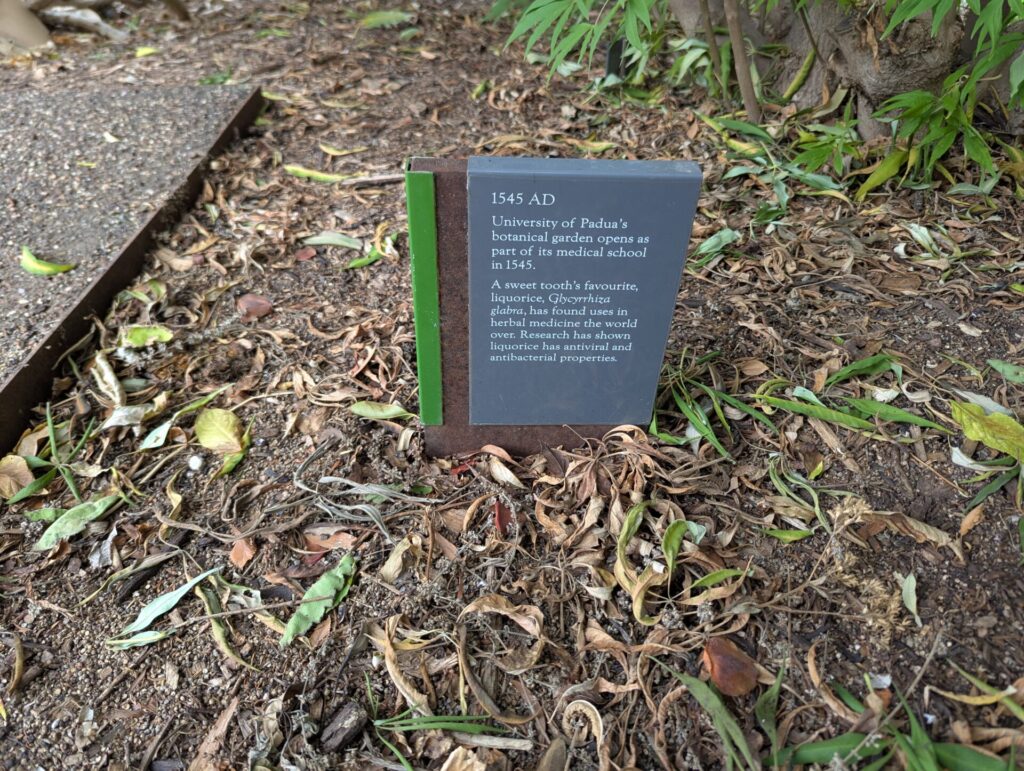
1545 AD
Padua’s Botanical Garden opens as part of its medical school in 1545.
Sweet tooth’s favorite licorice, Glycyrrhiza glabra, was found uses in herbal medicines the world over. Research has shown licorice has antiviral and antibacterial properties.
There are multiple studies to show various compounds from licorice inhibit bacteria and viri in the test tube. Whether as an antibiotic (i.e., inhibits a specific metabolic pathway) or an antiseptic (kills non-specifically, like alcohol) I cannot tell.
The probable mechanism behind these action is the inhibition of the protein synthesis, DNA gyrase, and dihydrofolate reductase.
Which to my mind suggests a nonspecific effect. Like tea tree oil. Oh, and licorice is a dietary abomination second only to walnuts. It is no sweet tooths favorite. That is enough to to discredit the plaque unless Swedish.
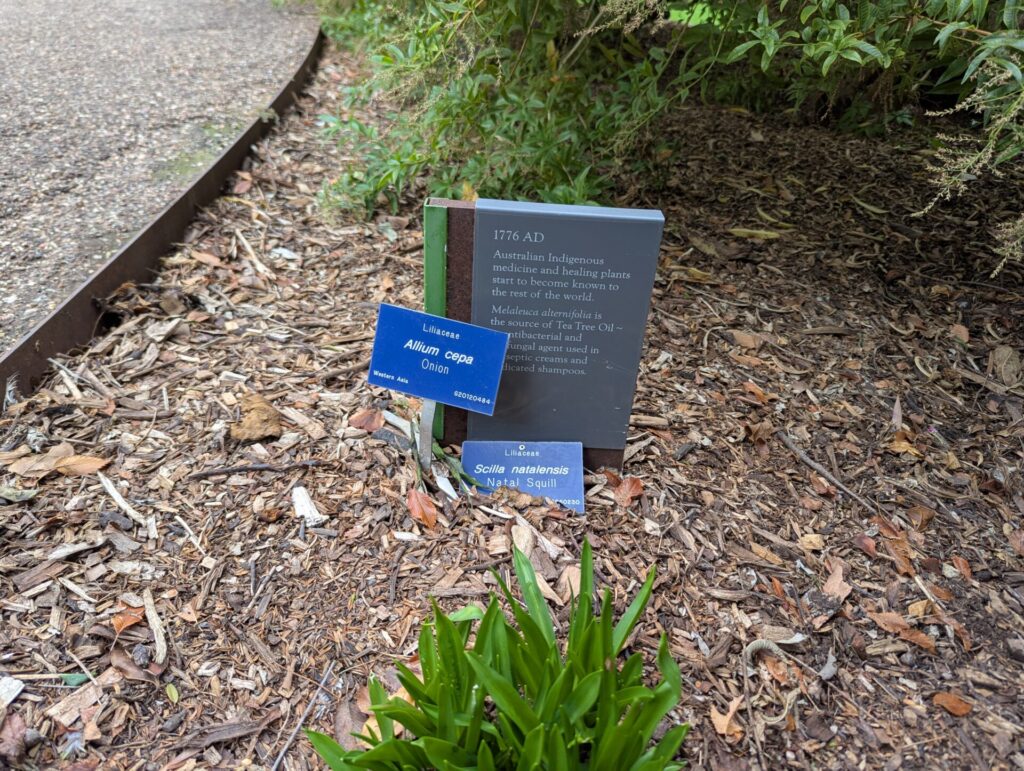
1776 AD
Australian and indigenous medicine and heating plants start to become known to the rest of the world.
Melaleuca alternifolia is the source of tea tree oil, antibacterial and antifungal agents used in antiseptic creams and medicated shampoos.
In contrast, contemporary data clearly show that the broad-spectrum activity of TTO includes antibacterial, antifungal, antiviral, and antiprotozoal activities. Not all of the activity has been characterized well in vitro, and in the few cases where clinical work has been done, data are promising but thus far inadequate.
Anything that kills that many microbial families is an antiseptic and melaleuca is an antiseptic, it just rips cell walls apart.
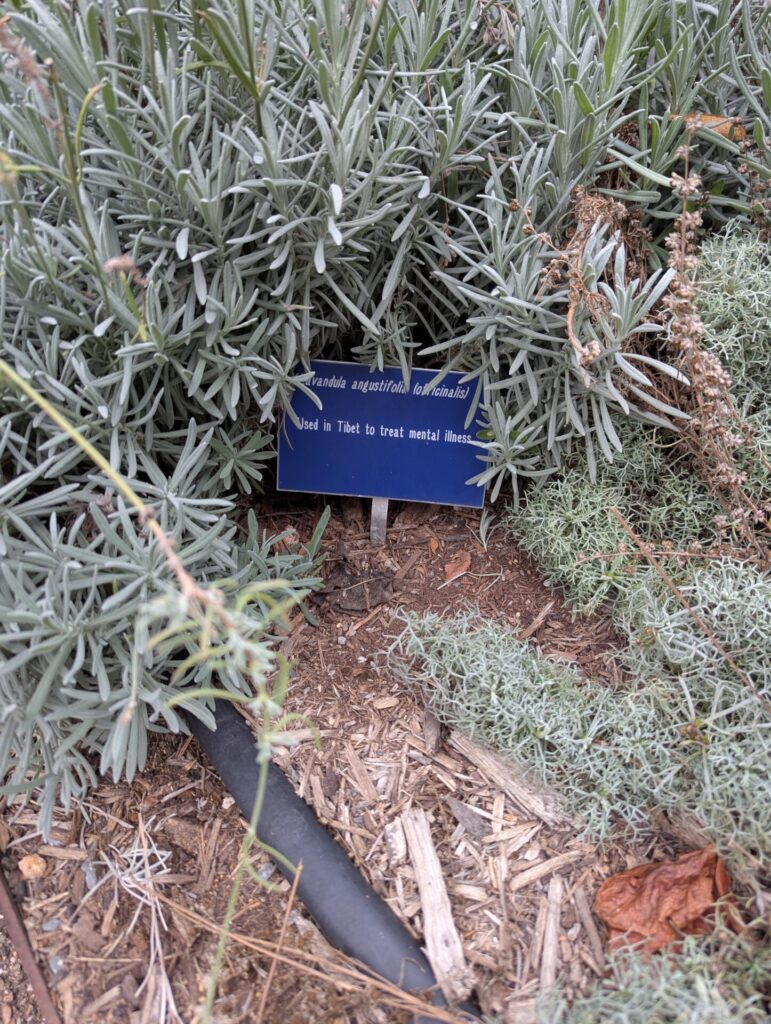
Lavandula angusifois
Used in Tibet to treat mental illness.
One study found
Our study showed that M. officinalis and L. angustifolia effect similar to fluoxetine in mild to moderate depression. (F = 0.131, df = 2,42, p = 0.877).
But
Conclusion: Due to some restrictions in this study, including absence of placebo group, large-scale trials are needed to investigate the anti-depressant effect of these two herbs with more details.
And a meta-analysis said
Lavender is beneficial, tolerable, and safe in treating depression. Despite obtaining promising results, they are not enough to recommend prescribing lavender to depressed patients. Further high-quality, large-scale studies for rectifying the shortcomings of existing studies are recommended.
Of course, there are more mental illnesses than depression. The Garden of Health is not all that specific as to what mental illness is being treated. But maybe.
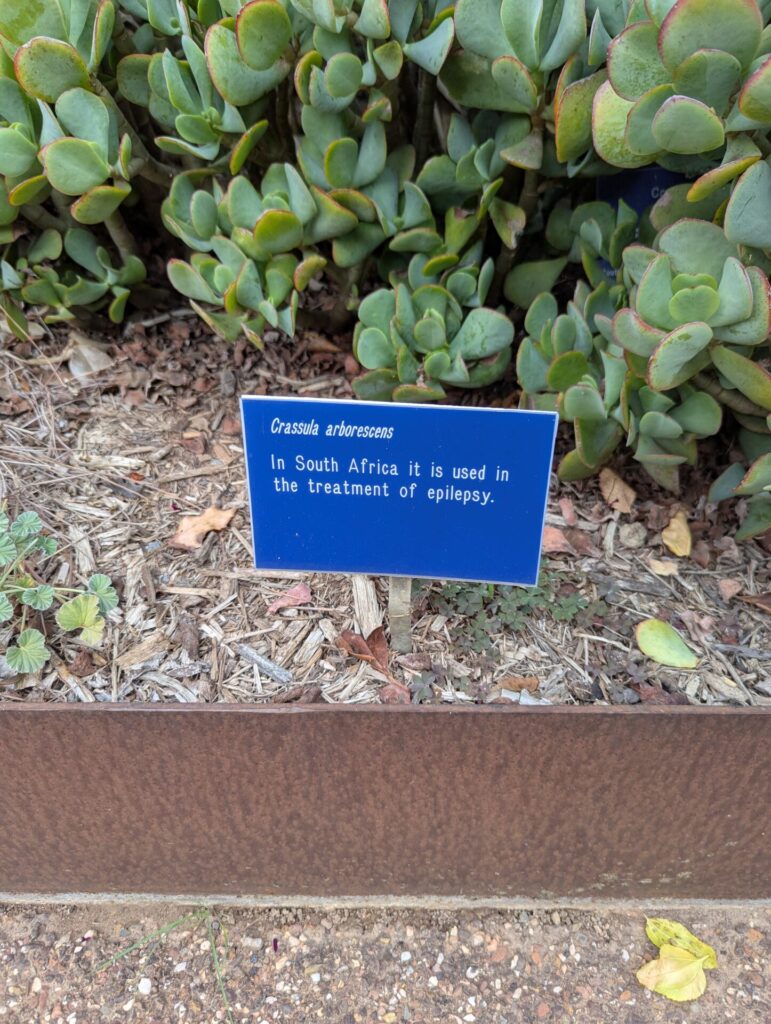
Crassula arborescents
In South Africa it is used in the treatment of epilepsy.
As well as diarrhoea, corns, and as a purgative. All diseases that have the same pathophysiology. Not.
A huge number of plants are used to treat seizures.
It may work in mice, but I could find nothing in humans except it is a toxic succulent.
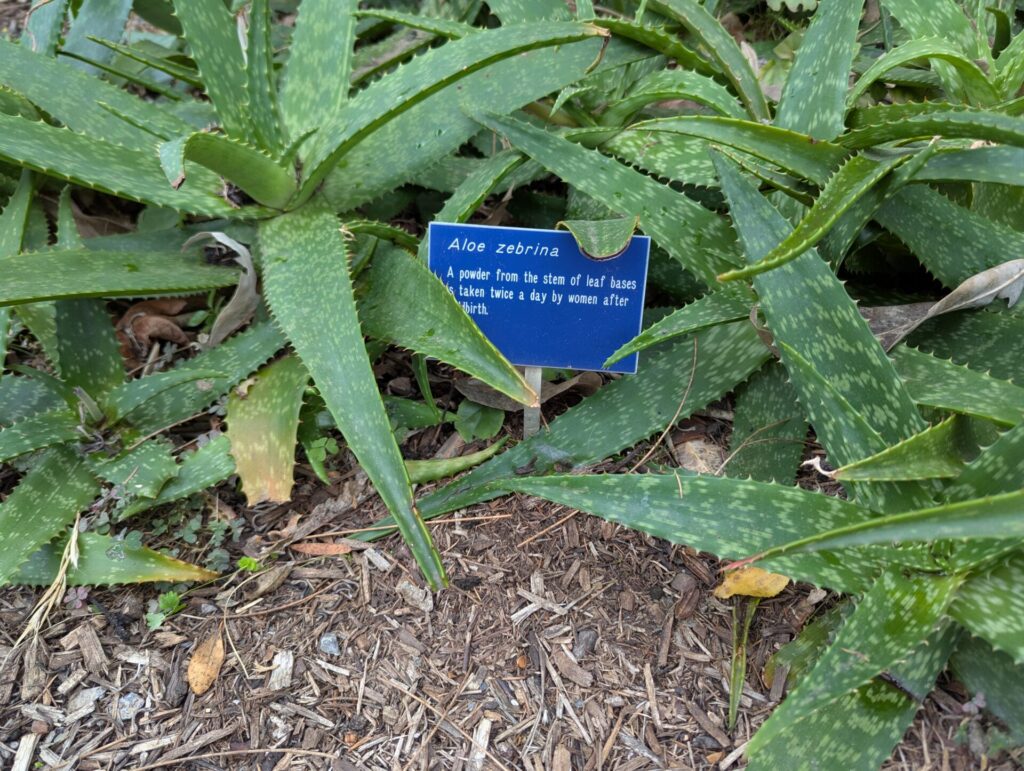
Aloe zebrina
A powder from the stem of leaf bases is taken twice a day by women after childbirth.
But why? They do not say. The web suggests it is to “cleanse the system.“
No idea what that means.
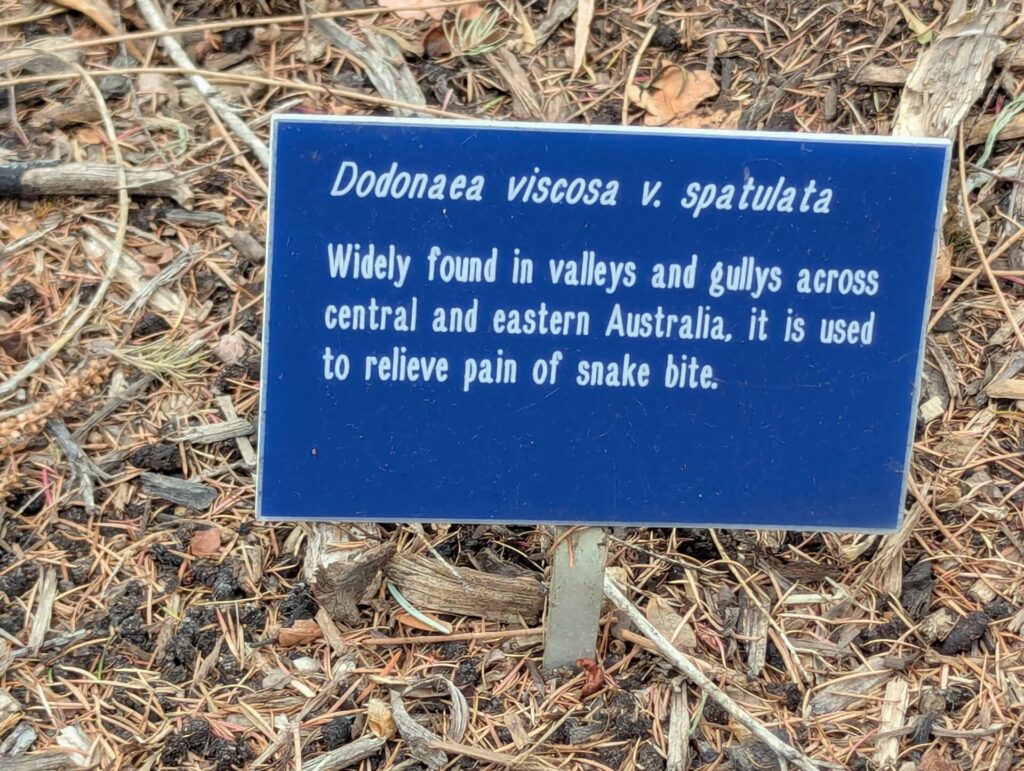
Dodonaea viscosa v. spatulata
Widely found in the valleys and gullys across central and eastern Australian, it is used to relieve the pain of snake bite.
Of course, no clinical trials. So who knows?
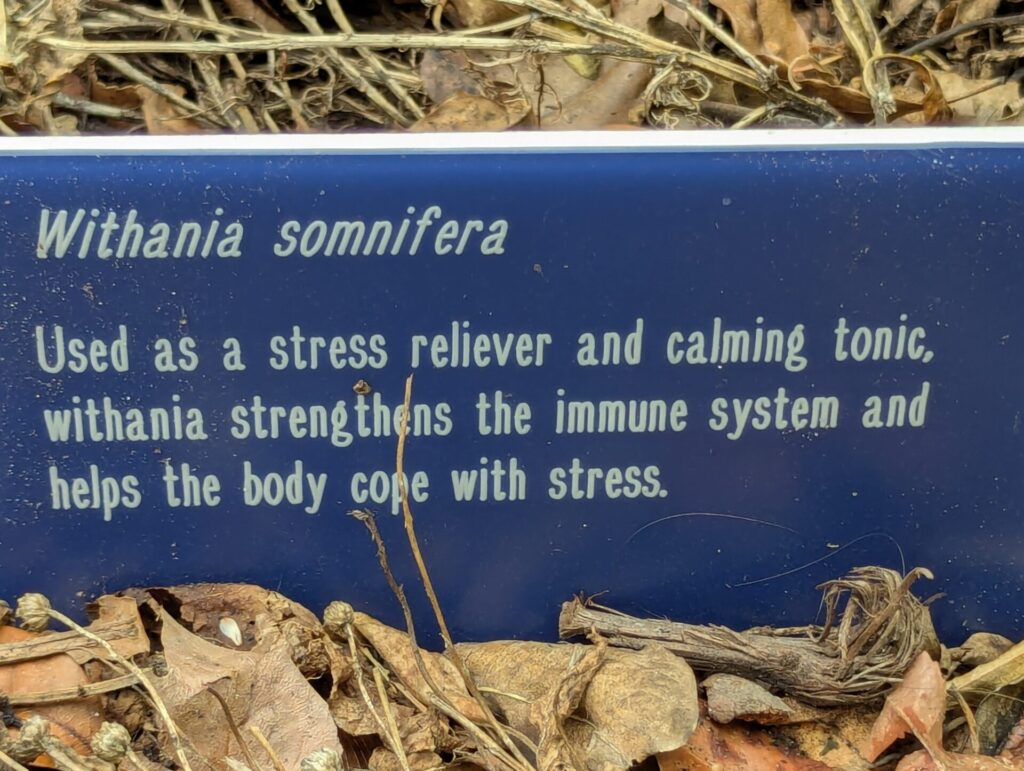
Withania somnifera
Used as a stress reliever and a calming tonic, Withania strengthens the immune system and helps the body cope with stress
What is a tonic? Dunno. We will go with the definition: A tonic is something, sometimes a medicine, that makes you feel better or restores you to health.
But in one review
Recent systematic reviews showed that supplementing stressed adults with Ashwagandha can decrease morning cortisol levels, indicating stress-relieving properties. Several studies presented benefits of Ashwagandha e.g., in fertility problems , anxiety, metabolic disorders such as dyslipidaemia, insulin resistance and diabetes, cognitive function, and obsessive-compulsive disorders.
And I have written several times on the silliness that is boosting the immune system. Basically, find the herb causing an inflammatory response, which is usually a bad thing if not infected.
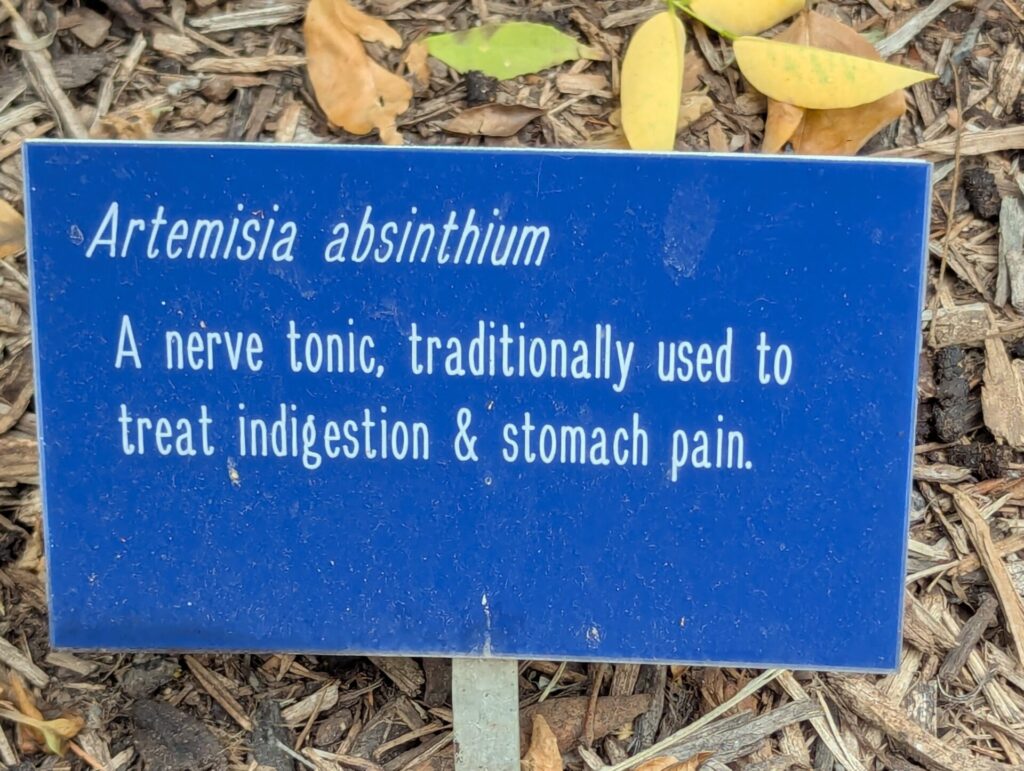
Artemisia absinthium
A nerve tonic, traditionally used to treat indigestion & stomach pain.
A nerve tonic? That is “believed to calm, soothe, or strengthen the nerves. It’s used to address symptoms like nervousness, anxiety, and irritability, aiming to restore balance and promote relaxation.”
Of course, as indigestion is, I suppose, due to nerves? I used to get the worst dyspepsia around midnight when on call as an intern. Cimetidine was released just in time to get me through the night. Perhaps I should have tried Artemisia absinthium.
As to the literature, I cannot find anything on Artemisia absinthium and clinical trials for either symptom on Pubmed, but a lot of other alleged uses. Which is common for a number of the plants. Each plant has TNTC potential uses, including treating broiler chicken coccidiosis.
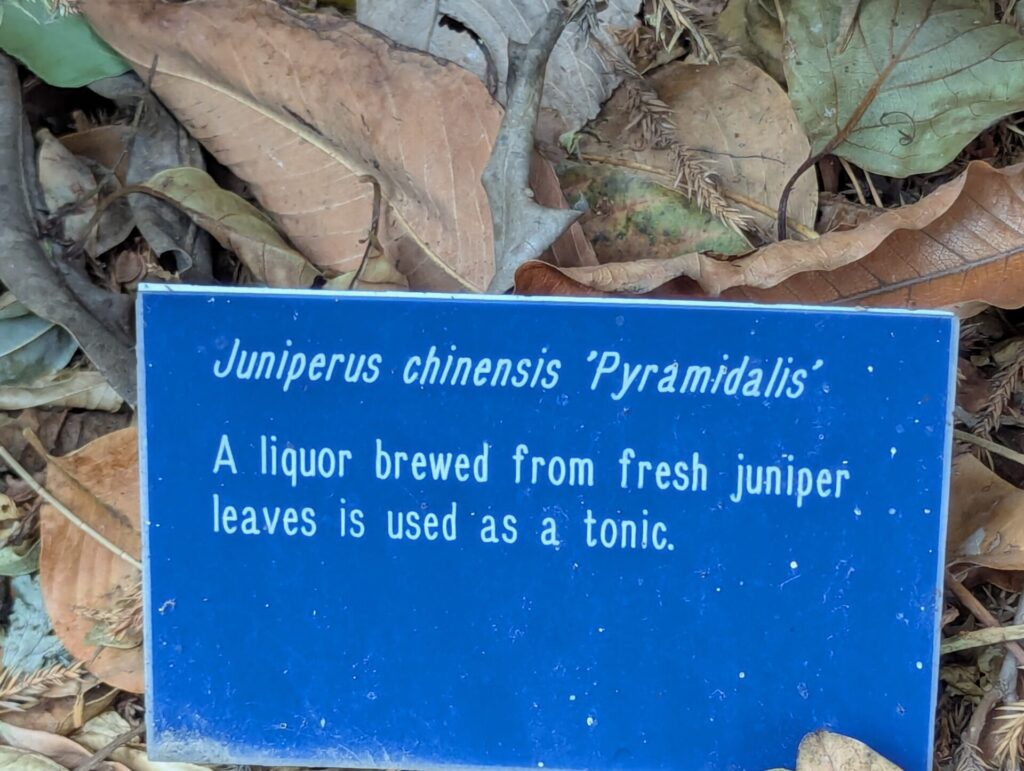
Juniperus chinensis ‘Pyramidalis’
A liquor brewed from fresh juniper leaves is used as a tonic.
Gin and tonic? Gin as tonic? Works for me. Wait. Gin has juniper berries, not leaves. Never mind. But a Pubmed search finds nothing on using Juniperus chinensis ‘Pyramidalis’ in a way that would be called a tonic.
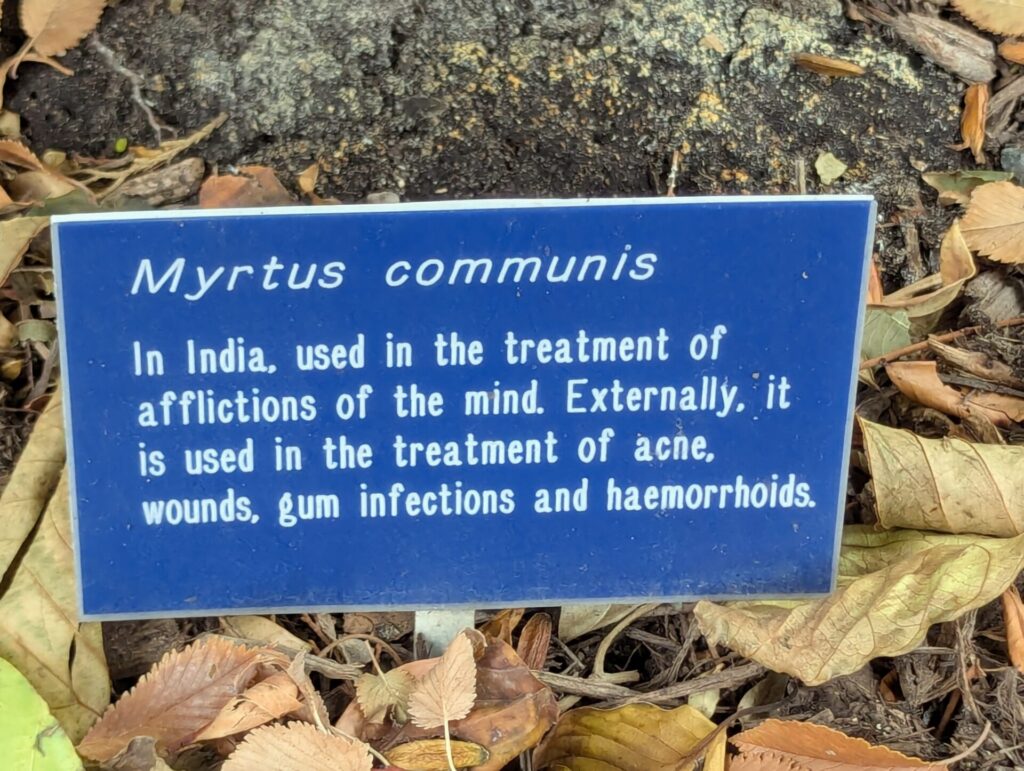
Myrtus communis
In India, used in the treatment of affliction of the mind. Externally, it is used in the treatment of acne, wounds, gum infections and haemorrhoids.
Whatever an affliction of the mind might be. Heather Nova might need it? Truly a wonder drug that works wonders,:
A pharmacological investigation revealed that M. communis possessed anti-inflammatory, analgesic, antimicrobial, antiparasitic, antioxidant, antidiabetic, anticancer, antimutagenic, immunomodulatory, dermatological, cardiovascular, central nervous system, and gastrointestinal protective effects, among numerous other biological effects.
Although I could find nothing that could be considered an affliction of the mind. But I do admire the way their plants can treat a diverse number of ailments that have nothing in common anatomically or physiologically. The opposite of the magic bullet of antibiotics. The early quote should have read.
From head to toe, inside and out, every plant for every part of the body.
But it may have efficacy against haemorrhoids. I will note that two of the three references in the updated review have nothing to do with haemorrhoids that I can find. It is always interesting to go back to the original material.
As to gum infections, wounds and acne, nothing on the Pubmeds.
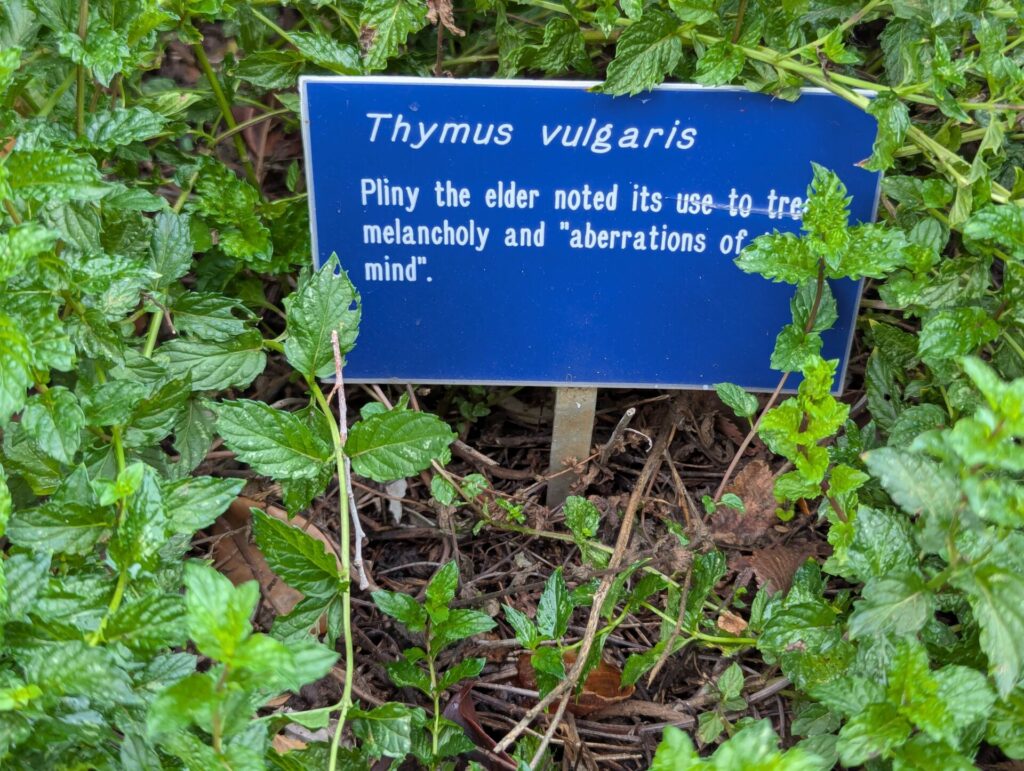
Thymus vulgaris
Pliny the elder noted its use to treat melancholy and “aberrations of the mind.”
CONCLUSIONS: Thymus vulgaris leaves, a traditional food source, demonstrate potential for enhancing both prospective and retrospective memory, alleviating anxiety and depression, and improving sleep quality in university students.
But there is but the one study
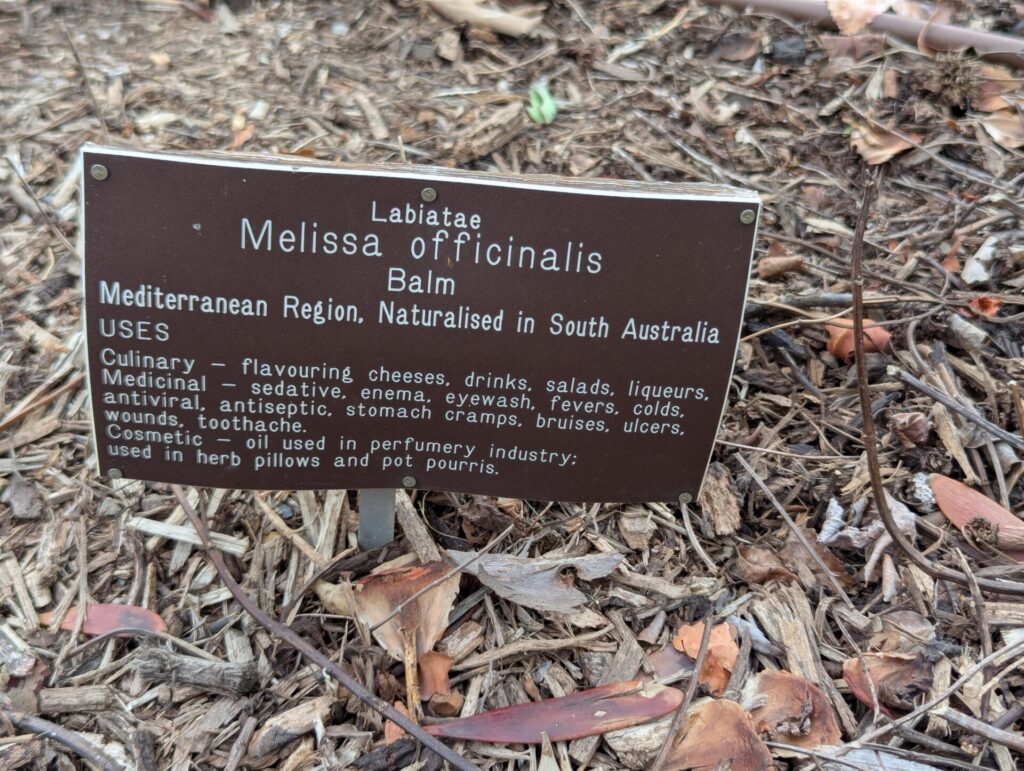
Melissa officinalis (Lemon Balm)
Uses
Medicinal – sedative, enema, eyewash, fevers, colds, antiviral, antiseptic, stomach cramps, bruises, ulcers, wounds, toothache.
As well as its multiple culinary and cosmetics
This is a widely studied product for multiple physiologic processes: herpes, depression, metabolic diseases as examples. No really compelling studies I could find and the meta-analyses all point to multiple methodologic flaws. So it may have effects, with ‘may’ being the most popular word in the conclusions.
But there was little in the Pubmeds for the uses listed in the Garden of Healing.
But at least the Garden of Healting were not totally gullible.
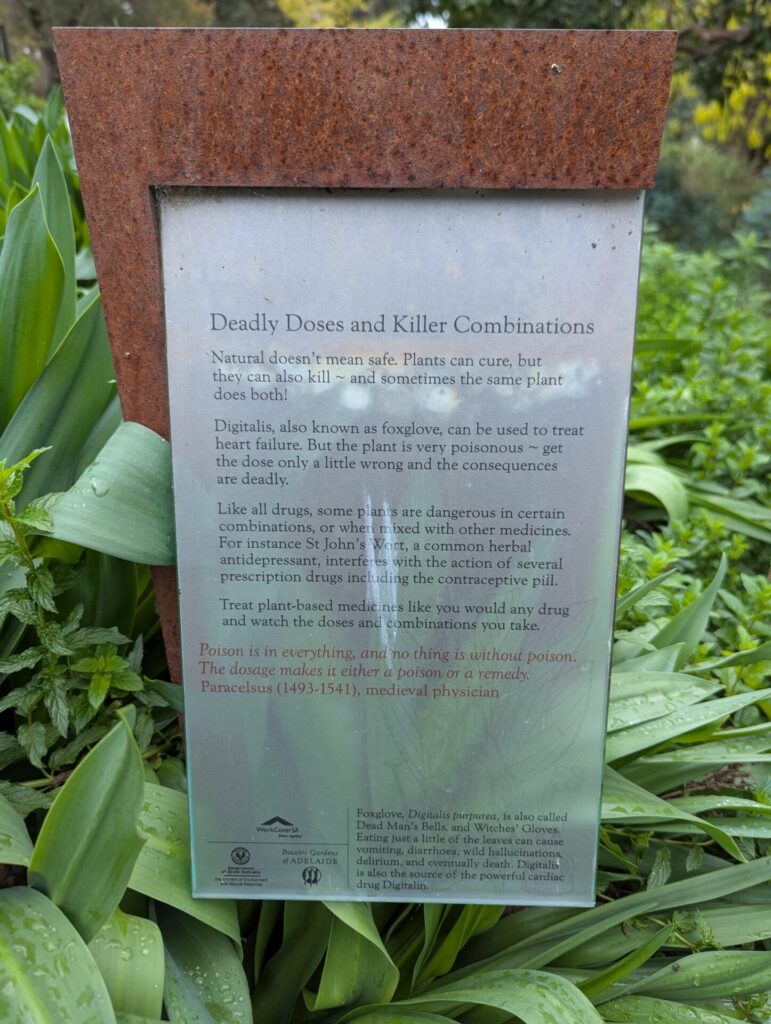
Deadly Doses and Killer Combinations
Natural doesn’t mean safe. Plants can cure, but they can also kill~ and sometimes the same plant does both!
Digitalis, also known as foxglove, can be used to treat heart failure. But the plant itself is very poisonous ~ get the dose only a little wrong and the consequences are deadly.
Like all drugs, some plants are dangerous in certain combinations, or when mixed with other medicines, For instance, St John’s Wort, a common herbal antidepressant, interferes with the action of several prescription drugs, including the contraceptive pill.
Treat plant-based medicine like you would any drug and watch the doses and combinations you take.
Conclusion? I was not overly impressed with the scientific rigor that went into the signs (for some reason I find the word signage annoying) at the Garden of Health. Most of plants had were either debunked or unsupported by reality, er, science, for their putative uses. I know they had limitations for space, but their results were just sad: vague, gullible, misleading and often unsupported by reality. I would have suspected the content was generated by AI.
However, it is a wonderful botanical garden to wander look at and marvel at the beauty and diversity of plants, even if the explanatory signs are blech.

